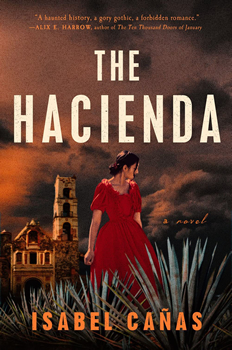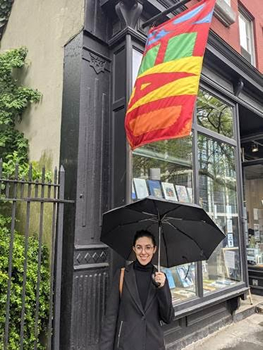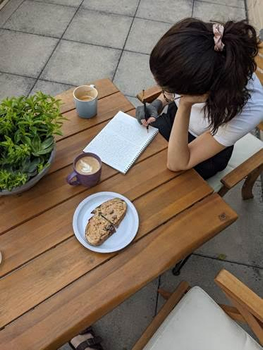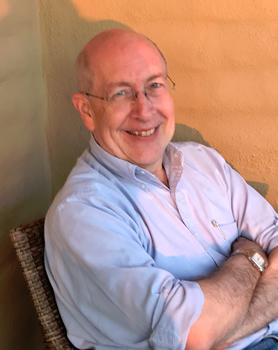

BookTrib Spotlight: Isabel Cañas
A Priest, A Bride, A Haunted Hacienda
It was my new conquest. My salvation. Mine…So why didn’t I feel safe when the enormous door of Hacienda San Isidro groaned open?
The speaker in Isabel Cañas’s remarkable blend of suspense, horror, romance, and supernatural gothic, THE HACIENDA, is Beatriz, 20, the new bride of a rich Mexican landowner named Don Rodolfo. The year is 1823, shortly after the bloody Mexican War of Independence, and Beatriz’s family had the misfortune of being on the wrong side. Now, her father dead, her mother reduced to poverty, it’s clear this marriage is the only way to claw her way out. She knows she should feel triumphant, but the air in her new home feels thick, and a chill sinks into her bones. A doorway is boarded up with mismatched wood and rusting nails, and when she decides that the next day she’ll bring light and fresh paint to the gloomy dining room, the room laughs at her, “light, bubbling laughter, like that of a wicked child.”
The house bears secrets, and so does everyone in and around it: her husband, whose first wife died under circumstances no one will discuss; his younger sister, Juana, who clearly runs the house but refuses to sleep in it; the very unpriestlike young priest who is newly come to town but already knows a great deal about San Isidro, its inhabitants, and…unearthly things. It is to Andres that Beatriz turns to for help, and he responds, but she has no idea of the depth of the malevolence surrounding her.
In the end, the only person she can completely count on is herself, and she’ll be damned if she’ll go down without a battle:
“A girlish giggle lilted behind me, toward me, carried by the breeze over my shoulder and into the courtyard before me.
“You’ll die here….
“But it would not be today.
“I was the daughter of a general, and I was not done fighting yet.”
THE HACIENDA is a magical combination, not only of genres and vivid character and story arcs, but of ideas—explorations of racism, oppression, power, resilience, and resistance. It’ll also scare the pants off you, its lush, hypnotic prose causing you to stare into the shadows.
Those two red lights? Are they eyes? Are they a cat’s?
But you don’t own a cat.
“THE HACIENDA sprang from a fairly unromantic place: rock bottom,” Cañas says now. “Before writing this book, I struck out on submission twice with Young Adult manuscripts; I was in Mexico City on my honeymoon when I received a particularly disheartening rejection. I knew I had reached a point in my career where I needed to try something different, or I would never sell a book. I’d been nursing the spark of an idea for a historical haunted house story, so I wiped away my tears and told myself I would try that project next.
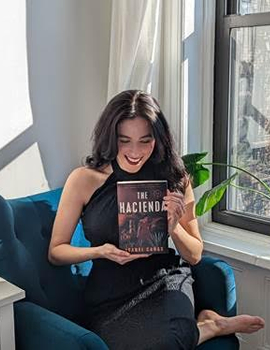
Cañas attempts to take photos to promote THE HACIENDA at home in Brooklyn with her husband—and laughs too hard to succeed. Photo credit: Robert Sturrock
“A few nights later, I lay awake in the dark, listening to a thunderstorm tire itself out sometime after midnight. As I drifted off, I heard a voice—crisp as the toll of a church bell—narrating what I immediately knew was a first chapter. I snatched my phone off the nightstand and began typing frantically, racing to pin the voice down before it slipped away.
“Those words became the first chapter of THE HACIENDA.
“The idea for THE HACIENDA first came to me as my novels’ ideas often do: as a vague constellation of archetypes and isolated incidents against a backdrop of atmosphere (or vibes, if you will). As I often do, I jotted down a long list of things I wanted to be in the novel: betrayals, ghosts, secrets, etc. From there, my type-A personality took over: I often spend weeks (sometimes even years) hammering out the plot, characters, and themes of my novels before I write the first line. I love texts like Save the Cat! Writes a Novel by Jessica Brody and Story Genius by Lisa Cron.
“However, THE HACIENDA took my carefully crafted process and unceremoniously chucked it out the window. Once the novel’s voice came to me in the middle of the night, I knew I had no choice but to begin, outlining be damned. I took my sketch of an idea, ignored its gaps, inconsistencies, and need for historical research, and wrote. I was writing in a long tradition of Gothic novels, so I reached for familiar archetypes: the young wife, the distant husband, the secretive family member, the untrustworthy servants. I knew I wanted an exorcism, so I threw in a priest for good measure.
“But then Padre Andrés stepped onto the page.
“I felt as if I was watching a movie in my mind’s eye as the young priest walked into the room, took a piece of charcoal from his pocket, and began to draw glyphs on the ground. A realization about him appeared in my mind as a fully formed sentence, as crisply as if someone had spoken it aloud: He is a witch.
“I lifted my hands off the keyboard in surprise. I had not planned that. It had not occurred to me to include witches in the book at all. But now the novel was irrevocably changed.”
The book altered her habits in more ways than one.
“Before THE HACIENDA, I primarily wrote short stories and fantasy, and for me, the driving energy in fantasy as a genre is wonder. THE HACIENDA is my first novel-length foray into horror, so it forced me to evaluate my craft in unexpected ways. Horror is a genre of tension and suspense, of atmosphere and feeling; I had to teach myself a lot about how to precisely wield tone and voice. I worked hard to imbue setting with feeling and to better control my pacing.
“I think all writers should try their hand at horror—it really demands that the writer inspire deep feeling in the reader. Sparking fear and dread without all the haunting music and jump scares that movies have requires a precision and control of tone, voice, and atmosphere that other genres don’t. I know my writing in other genres will be better for it.”
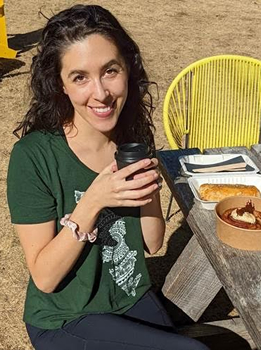
Cañas spends every Christmas and August on Pender Island near Victoria, British Columbia, staying with her in-laws and writing. Photo credit: Robert Sturrock
Cañas wrote the book with other forces in mind, as well. Beatriz starts out as a victim, for instance, but gains more and more agency as the book goes on, making her a slightly unusual Gothic heroine.
“I crafted Beatriz’s arc with intention and in direct conversation with Daphne du Maurier’s Rebecca. While I couldn’t get enough of the mystery, dread, and atmosphere of that novel, the passivity of the unnamed protagonist left me deeply frustrated. There were so many times that I wanted her to lash out, to act out, to do something to push back at the ghosts of Manderley. (Perhaps this was me projecting on the text—I am a passionate person, haha!) When I sat down to write the climax of Beatriz’s arc, I knew I wanted her to push back. I wanted to read a character who would fight her way tooth and nail out of that haunted house, so I wrote one.”
Also important to include was her own heritage. “As a young Mexican-American reader, I struggled to find representation in fiction, especially genre fiction. It simply wasn’t there. I clung to any brunette on the page, desperate for mirrors that reflected my own experience of feeling out of place in spaces that should feel like home.
“One of my goals as a writer is to portray my own experience of being Latinx in all of my writing, whatever the genre, because traditional publishing still lacks the diversity of the Latinx experience. The experience of being Latine/Latinx is not a monolith—we have different historical experiences with colonialism and migration and diaspora, we’re different races, we have roots in different countries, we speak different languages. I hope my work will become one piece of an enormous, colorful stained-glass window of Latinx representation and that settings like THE HACIENDA’s will no longer be considered ‘unusual.’”
That emphasis is reflected in many of her other influences as well.
“When I think about THE HACIENDA’s provenance in particular, I trace my ability to write it back to several key texts. Many readers will already be familiar with Isabel Allende and her The House of the Spirits, and certainly Shirley Jackson’s The Haunting of Hill House, but Juan Rulfo’s Pedro Paramo was also deeply influential on me and my work—it is a haunting classic of modern Mexican literature that I think too few readers in the US know about. I also must acknowledge the immense impact that Beloved by Toni Morrison had on me when I first read it in university at 19.
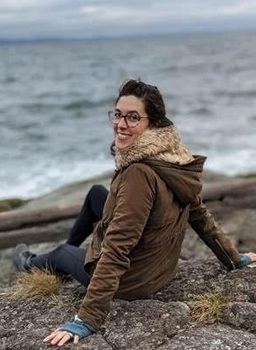
Cañas in Victoria, British Columbia, where her husband’s family lives and where she spends her most creative months
“I was also deeply influenced by my upbringing, which in the novel is made manifest in the character of Padre Andrés. As far as the supernatural is concerned, his belief system is fiction—I wanted to build a worldview for this character that was respectful of and informed by folk beliefs I learned from my mother and other family members, but also by the specific colonial context of nineteenth-century Mexico and its religious syncretism. But I was also raised in a deeply Catholic household by parents from different cultural backgrounds; from a young age, I was haunted by questions of faith, identity, and belonging. Beatriz and her battle of wills with Hacienda San Isidro are the heart of this novel, but Andrés is its soul.”
A bit of extra research helped, too. Much of her writing process may have been “chucked out the window,” but not all of it. Caña is a PhD student of medieval Turkish literature, and her academic background proved invaluable.
“Absolutely! It deeply informed how I researched the crucial, politically complicated period directly following the end of Mexico’s War of Independence (1810-1821). I used my university’s resources for secondary literature and primary sources and read as widely as I could. I learned that in 1823, two years after the end of this economically disastrous 11-year war, money was scarce. But I also knew that I wanted my novel to be shaped by the classic Gothic trappings of a grand old house and a mysterious new, wealthy husband. So as I sifted through monographs and 19th-century documents searching for the right setting, I let my historian’s brain take over: I followed the money.
“That money trail led to pulque. It led to haciendas in a region that is now the state of Hidalgo. Once I got there and looked around, I was off to the races!
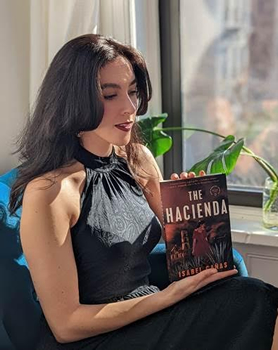
Cañas’s husband took all her promotional photos for THE HACIENDA at their home in Brooklyn. Photo credit: Robert Sturrock
“As I researched, the most surprising thing I discovered was a random government text. On a trip deep into the stacks of my university’s library, I discovered a slim, half-hidden volume called Descripción geográfica y estadística del distrito de Tulancingo, written by a government bureaucrat named Francisco Ortega in 1825, just two years after the events of my novel. It includes descriptions of the landscape of what is now the state of Hidalgo, its flora and fauna, population and demographic breakdown, water sources, weather patterns, and more—details that really help a writer nail the feel of a setting. Anyone who has written historical fiction can immediately recognize that sources like these are absolute gold mines! It was kismet that I stumbled across this dry government text; THE HACIENDA simply wouldn’t be the same without it.”
All of these factors—the inspiration, the genre, the research, her heritage and upbringing—came together to produce the breakthrough that had taken her so long to achieve. As she mentioned at the top of the interview, before THE HACIENDA, Caña had hit rock bottom.
“In 2017, I participated in PitchWars and found my incredible agent, Kari Sutherland, through that mentorship and pitching contest (albeit indirectly). We sent my first YA fantasy manuscript out in spring 2018. It was but the first step on a rocky road to publication rife with rejections, revisions, not-quite-acceptances, and not-quite-good-enoughs. When I griped about rejection, my mom commented that I was in the middle of my 10-year overnight success story, and to keep my eyes on my own paper.
“It was excellent advice, and I followed it. In doing so, I worked hard to hone my craft: I attended the life-changing Clarion West Writers Workshop for SFF writers and, whenever I could squeeze space in my PhD schedule, I took online classes through Odyssey Online and Catapult. Every year, I challenged myself to read 52 books (though by the time December rolls around, I binge read a lot of novellas). I firmly believe that a writer’s learning is never through. If you’re stuck in the middle of your own 10-year overnight success story, I encourage you to find ways to keep studying craft and trying out new genres, voices, and categories. You never know when you’ll strike gold.”
Her own gold strike will be continued in two ways.
“I’m currently working on finishing my PhD dissertation! I’m in the final stretch (I’ll be defending my dissertation in May), and it has become all-consuming. Once I’m finished, however, I’ll return to the draft of my next novel for Berkley and revise it. I can’t say much about it yet, but I will drop one hint: It takes some of the ingredients that made THE HACIENDA what it is (19th-century Mexican history, the supernatural, and a heaping dose of romance) and takes them in a surprising new direction. I’m utterly obsessed with the characters and hope that readers will be too!”
When asked for any final words, she had this to say, which has echoes for us all after a long, hard couple of years: “I feel blessed that my first published novel is also one that has deep emotional importance for me. When the pandemic began in 2020, the books that I turned to in past years for escape—rich, immersive fantasies—no longer hold my attention. I began reaching for novels that were more frightening, desperate to be suspended in a marvelously spun story. Nothing alleviated my anxiety. Instead, I pulled out a half-finished draft about a haunted house, a stubborn heroine, and a troubled priest, and I poured all my fear into it. In a way, THE HACIENDA is a relic of that early pandemic experience, for it became a story about being trapped in a house—an experience that in 2020 became as frighteningly universal as a fear of ghosts. I don’t know what the world’s troubles will look like when readers find this novel, but it is my sincere hope that by transporting them to a dark, mysterious house of spirits, THE HACIENDA can sweep them away, at least for a short while.”
*****
Neil Nyren retired at the end of 2017 as the executive VP, associate publisher, and editor in chief of G. P. Putnam’s Sons. He is the winner of the 2017 Ellery Queen Award from the Mystery Writers of America. Among his authors of crime and suspense were Clive Cussler, Ken Follett, C. J. Box, John Sandford, Robert Crais, Jack Higgins, W. E. B. Griffin, Frederick Forsyth, Randy Wayne White, Alex Berenson, Ace Atkins, and Carol O’Connell. He also worked with such writers as Tom Clancy, Patricia Cornwell, Daniel Silva, Martha Grimes, Ed McBain, Carl Hiaasen, and Jonathan Kellerman.
He is currently writing a monthly publishing column for the MWA newsletter The Third Degree, as well as a regular ITW-sponsored series on debut thriller authors for BookTrib.com and is an editor at large for CrimeReads.
This column originally ran on Booktrib, where writers and readers meet.
- LAST GIRL MISSING with K.L. Murphy - July 25, 2024
- CHILD OF DUST with Yigal Zur - July 25, 2024
- THE RAVENWOOD CONSPIRACY with Michael Siverling - July 19, 2024

